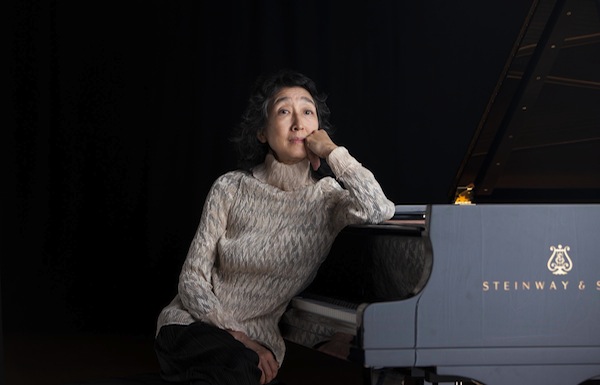Uchida’s Schubert contains multitudes at Carnegie Hall

Mitsuko Uchida performed Schubert sonatas Friday night at Carnegie Hall. File photo: Justin Pumfrey
Just when you think you have Mitsuko Uchida figured out, she turns your world upside down.
Friday night at Carnegie Hall, the esteemed Japanese pianist was nearing the midpoint of a four-recital series presenting Franz Schubert’s 12 completed piano sonatas. (Two recitals in spring 2019 will complete the series.) The opening concert on Monday had been a meditative experience, as Uchida gently and unhurriedly illuminated every corner of Schubert’s rich scores.
Friday’s program began in that same rewarding way. Then the artist encountered the program’s closing work, the Sonata in D major, D. 850, and all hell broke loose.
This sonata is undoubtedly the most energetic and extroverted in the series, but in Uchida’s hands it was more than that—a roar, a flood, a tempest to match the nor’easter that was blowing outside the hall Friday night. Schubert’s abundant ideas tumbled over one another in a rush of triplet figurations. Everything froze for a minatory trumpet call, and then the race was on again, fortissimo piling on fortissimo, the pianist’s slender hands plunging into the keys and lifting her off the bench.
Following this barrage, the pianist backed off just slightly in the exposition repeat so that listeners could hear it all again and actually make out what was going on. The development had its playful moments and even a soft-pedaled passage or two, but the movement ended the way it had to, barreling like the night freight train straight through the coda to the final chord.
In this bold sonata, even the slow movement is marked Con moto, with motion. Uchida, however, traded moto for meditation, softly inflecting each of the theme’s short-breathed phrases, letting the rhythm fall where it may. From this modest beginning grew an ambitious movement, its theme richly elaborated in each appearance, with a sharply etched syncopated theme for contrast, and passionate fortissimo chords at the climaxes.
The sonata’s scherzo was, of course, the maximum-energy variety, with chugging chords and a sock of syncopation, but Uchida danced lightly in the answering phrases and charmed with the rugged theme’s waltz variation. Hazy legato chords brought relief in the trio.
One wondered what the inflector-in-chief would do with the finale’s naïve skipping theme and tick-tock accompaniment, and the answer was: nothing at all. Or rather, just enough to let the tune’s child-like charm shine through. The steady beat moved this rondo gently through pastel-colored episodes—perhaps a little too faint in the more “adult” lyrical second theme—and sparkling variations on the main theme, to a soft coda of ineffable charm and tenderness. It was a breathtaking ending to a sonata, and particularly a performance, that began with such demonic energy.
The first two items on the program found Schubert looking for, then finding, his authentic sonata voice. His Sonata in B major, D. 575, composed in 1817, threw together heterogeneous ideas in its first movement; Uchida’s alert playing gave each element its due, and even got them to hang together. She skillfully steered the Andante’s hymn-like tune to its fortissimo climax in big chords and roaring octaves. The playful scherzo was fluidly played, never square. And if not even this imaginative pianist could save the closing rondo from monotony, at least it was brief.
Composed eight years after D. 575, the Sonata in A minor, D. 845, was on another plane of mastery, evident from the very first bars, with their soft, tense call-and-response. As the score’s dramatic events unfolded, Uchida paused to savor each one—illuminating to be sure, but also robbing the movement of momentum, so that the hammering fortissimo conclusion sounded not so much inevitable as tacked on.
The theme of the Andante poco moto sounded flexed and somewhat fussy at first, making this listener wish to hear, just once, a simple tune played simply. (As noted, this wish was fulfilled later in the program.) But the five variations that followed were so vividly characterized that their rhythmic liberties felt quite appropriate.
Uchida bounded around the keyboard in the swashbuckling scherzo, then viewed the shepherd’s-musette trio through a haze of soft piano tone and swimmy rhythm. Hinting at the big D major sonata to come, she gave this sonata’s closing rondo a wild edge, announced by a blur of fast 16th notes and a snap of crisp loud chords. Episodes both tuneful and forceful had their say, the music often threatening to run off the rails but never doing so, until the volatile coda ended it with a dramatic decrescendo-and-boom.
Following her intense performance in the D major Sonata, a drained-looking Uchida returned to the stage and played a single encore, the tender Sarabande from Bach’s French Suite No. 5 in G major, BWV 816.
Carnegie Hall will present pianist Pierre-Laurent Aimard in Beethoven’s “Hammerklavier” Sonata, Op. 106, and works by Obukhov, Liszt, Messiaen, and Scriabin 8 p.m. Thursday. carnegiehall.org; 212-247-7800.